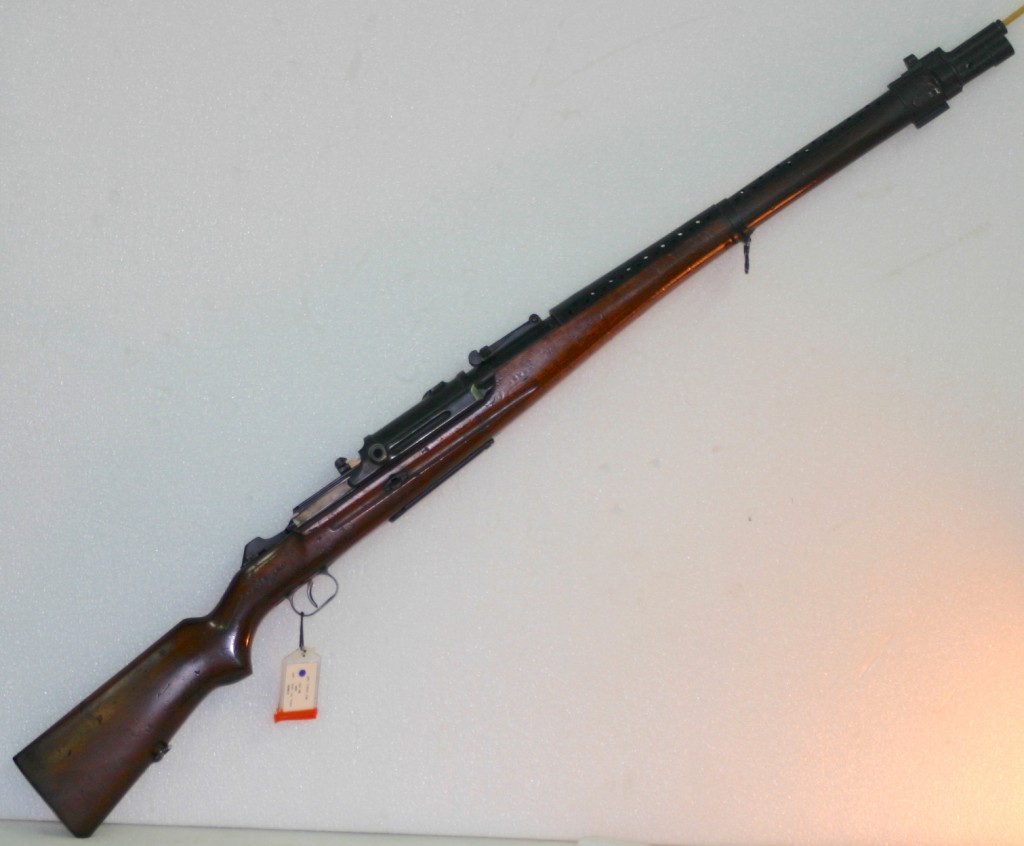
One of the first semiautomatic rifles tested by the US military was a design by a Dane named Søren Hansen Bang, which was first presented to the government in 1911. The rifles used a gas trap design which would ultimately inspire many other designers include John Garand. Basically, a sliding nosecap in front of the muzzle would capture some of the gasses from firing and be pushed forward, which in turn pulled a connecting rod and caused a lever to throw the bolt backwards. Complicated enough?
Anyway, thanks to the National Firearms Centre in Leeds, we have some photos of a .303-caliber Bang rifle sent to England for British trials. I don’t know the exact date of the trials, but the NFC lists it as a model 1927 rifle.







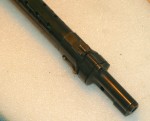
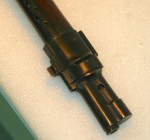
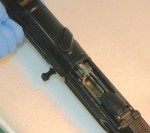





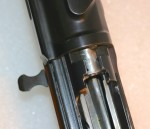



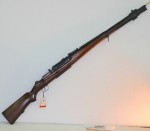

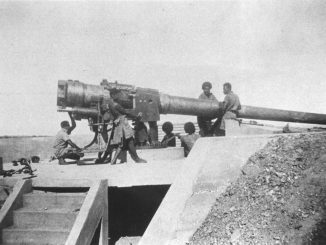
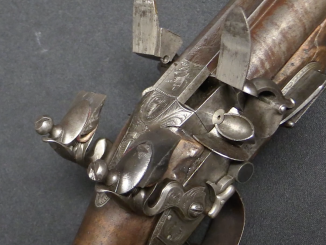
Thank you very much for the details and the close ups of the mechanism! Awesome!
As noted elsewhere in the gun history press: “Army punsters don’t know how close they came to being issued with U.S. rifle, M1 Bang!”
Faulted for a light barrel that caused vertical stringing.
A 7 shooter like that submitted to U.S. trials?
If anything, I’d say John Cantius Garand was influenced by the cam mechanism to rotate the bolt lugs in and out of the locking recesses.
Hiram Maxim’s first self-loader used a heavily modified lever-action rifle, where the gases behind the bullet escaped the muzzle, pulled a block forward slightly, which pulled a slender op-rod forward, which then actuated the “lever” mechanism to open the action, extract and eject the cartridge case. Springs then returned everything so that the bolt chambered a new cartridge. I guess ol’ Søren Bang took the idea to its limitations, no?
Very interesting post. Thanks again!
You are describing Browning’s first self-loader. Maxim’s first self-loader relied on a spring-loaded reciprocating buttplate to achieve self-loading operation.
“You are describing Browning’s first self-loader”
Which later evolved into Colt Potato-Digger machine gun, however with gas-port in barrel.
As much as I try to be straight faced about it, the Bang rifle inevitably gets a chuckle out of me due to the name, it’s just too wonderful to ignore.
If you are looking for designer name coincidences see Токарев, in Russian “токарный станок” mean “lathe”
If your customer doesn’t want a gas port drilled into the barrel, the Bang system makes more sense.
Manufacturing these must have been time consuming.
“Manufacturing these must have been time consuming.”
When compared to what?
Remember that in early 20 century, machining was commonly used.
Sure, but it all comes down to how many machining operations have to be performed. The early French auto loaders seemed to have cleaner lines, although they didn’t use the same operating system. U.S. colonel James Hatcher designed a similar rifle that was simplified and said to be stronger. I am sure there were more complex guns out there, so I won’t compare it to them. 🙂 While the early gas trap Garands used a modified Bang system, it’s said that John Garand designed his guns with an eye to manufacturing, I don’t know for sure.
Incidentally, Springfield Armory has a picture in their archives of a 1922 Bang rifle that has the bolt turning in the opposite direction.
1939 prices (in rubles) for Soviet fire-arms:
Nagant Model 1895 (with spare parts): 85 (factory number 173)
Tokarev Model 1933 (with spare parts): 84 (factory number 173)
PPD model 1934/1938 (with spare parts): 900 (factory number 2)
Mosin Model 1891/30 (with spare parts): 166 (factory number 74)
Simonov automatic rifle (with spare parts): 900 (factory number 74)
SVT self-loading rifle: 2000 (factory number 173)
Maxim machine gun (with spare parts): 1760 (factory number 173)
Maxim machine gun (with Sokolov mount and spare parts): 2635 (factory number 173)
DP machine gun (with spare parts): 1150 (factory number 2)
DT machine gun (with spare parts): 1400 (factory number 2)
ShKAS turret/wing machine gun (with spare parts): 1650 (factory number 74)
ShKAS synchronized machine gun (with spare parts): 3100 (factory number 74)
DShK machine gun (with spare parts): 12000 (factory number 74)
As you can see SVT-38 was more expensive than Maxim machine gun or even ShKAS (then state-of-art technology machine gun) also notice high price of PPD-34/38 (over 5 time more than Mosin) which led to PPSh sub-machine gun.
Great research. As I understand, Comrade Stalin wasn’t big on price haggling. People who were troublesome didn’t fare that well. Sam Colt was overcharging for his revolvers in the 1860’s but came down in price when Remington offered to make them for half price.
If that rifle was any longer they could’ve invaded Normandy without crossing the Channel.
Okay, I can see what Mr. Bang was thinking. He wanted to use gas-operation without drilling into a gun barrel (remember we have corrosive primer residue around at this time). Like other gas-trap designs, it is optimistic but doomed to failure on the part of mechanical complexity. The mechanical complexity of the gas-trap design is the trade-off for keeping the rifle as a maintainable unit that won’t be thrown away entirely due to corrosion. The gas trap is replaceable, the connecting rods are replaceable, but the barrel is not really replaceable! Spare barrels are for machine guns, not for rifles (if you lived in Depression Era Europe).
Weapon of choice scenario:
[radio static]
Alright, where was I? Oh yeah, we’ve been wandering around with about two truck loads of “terrible” guns and ammo and maybe an anti-tank piece. My compass is broken, and one of our “friends” in this convoy lost our map of this strange, rocky desert. All I remember for directions prior to our map being gone with the wind is that the sea is to the north (and please don’t try fishing, I got attacked by sharks thrice and I don’t think you want shark steak again).
Friendly forces are looking to get us out of this mess but it may take them a day or two to reach our position no thanks to those stupid “religious” extremists blocking the way with black-market AA missiles and HMGs. And no, the bandits aren’t stupid enough to believe they are bullet proof. Be aware that the bad guys can hide in the rock formations while we’re stuck near the beach.
If you’re stuck with me in this mess of Einheitzdiesels and a “nearly forgotten motor pool,” please take up a weapon from this first list:
1. Scotti Model X
2. Bang Rifle
3. Fiat-Revelli Modello 1914
4. RSC M1917
5. Mkb-42 (W)
6. Cannone-Mitragliera da 20/77 (Scotti)
7. Autocannoni da 90/53 (this is a truck mounted heavy AA, mind you)
8. Polish Wz. 34 armored car
9. Humber Light Reconnaissance Car
10. Morris CS9
11. BA-6 heavy armored car
12. Screw this! Get the Panzer IV Ausf. H and kill everyone on the other team!
If you are on the rescue team, just pick one of the “great items” on the next list:
1. M1 Garand
2. Browning M2
3. Thompson, any Thompson
4. M-16
5. Lee-Enfield
6. Churchill Mk IV
7. Tiger I
8. Apache attack-helicopter
9. Add your favorite toys to this list!!!
Go get your toys, kill everyone in your way!
Disclaimer: This dual mission set is voluntary and therefore not considered a serious discussion of the material discussed from the parent article. You are not required to participate in getting lost or saving anyone from being lost in the text. Please keep any and all criticism of this post humane and free of foul language.
Thank you,
Cherndog
IIRC, the major problem with this system was it required a large volume of cooler, low pressure gas at the muzzle when compared to a gas port design. This resulted in more residue and the weapons became unreliable. After adoption, the M1 Garand was quickly redesigned into a gas port weapon.
That is an interesting scenario that you set up, and I’m not sure what to say. Air support definitely seems reasonable. My fantasy lies along a different line. If you could buy a kit with a Bang gas system that you could screw into an 870 barrel and had a recoil reducing gas mechanism in an extended magazine tube, would that make 870 Competition owners jealous. You would still have full magazine capacity, reduced recoil and no gunsmithing required. Kind of like combining 2 decent ideas that really went nowhere.
Ooh. Great idea. Would it be a good idea or a bad idea to add a heat shield over the barrel and fix a bayonet lug near the false muzzle?
A BAR would make a fine addition to your second list. I was thinking more along the lines of millions of 870s used for hunting, but occasionally used for clay pigeons. An easy on/easy off kit might spare some aching shoulders. The heat shield would be great if my idea actually worked.
“If you’re stuck with me in this mess of Einheitzdiesels and a “nearly forgotten motor pool,” please take up a weapon from this first list:”
Get Italian Autoblinda 41 armoured car (4×4), which was used in desert by Italy and well-liked by its crew.
“9. Add your favorite toys to this list!!!”
Some long-range aircraft might be useful. Get Vickers Wellington (which in reality was deployed in Middle East): https://en.wikipedia.org/wiki/Vickers_Wellington which have range 2550 mi or if impossible, get earlier Vickers Wellesley. In 1938 Wellesley modified with additional fuel tanks set Aeroplane Distance World Record at 7162 mi (11525 km) flying from Ismailia to Darwin (Australia)
I have terminal cancer and this place is on my bucket list I live in the UK so that shouldn’t be a problem. I would like to say a big thank you to Ian
for keeping me informed of interesting firearms. Keep it going, Ian!
is there a reason why operating a more conventional gas piston or DI with gas captured at a muzzle cap wouldn’t work? would it be too low pressure? too slow?
How about “Mr. Bang didn’t think this through or feared infringing upon somebody else’s patent?” Bang was likely caught up in an environment where patent trolls where practically everywhere. If he simplified his design, somebody might sue him for patent infringement and use design similarity as evidence against him in court.
Does anybody, anywhere has patent claim for gas port in barrel? Can “gas port” be considered as a “patent claim”?
I don’t know, but Bang would have to have made it clear that his weapon was not a machine gun, since machine guns with gas ports were already patented. If Bang’s rifle had a conventional piston setup, somebody might sue him for making a “semi-auto only copy” of the latter’s light machine gun.
Not all ordnance departments were keen on drilling ports in barrels. https://www.forgottenweapons.com/german-ww2-rifles/gewehr-41w/
The rifles trialed were:
The Menteyne-Degaille
The Kjellman
The Hallé
The Roth
The Sjogren
The LSA
The Mondragon
The BSA
The Brauning
The Rexer
The Farquhar-Hill
The Revelli
The Bang
The Hellfeld
The Tatarek
The Kretz
The Federov Avtomat
The Vickers
The Fidjeland
The Cei-Rigotti
The Shoube
The Laird-Menteyne
The Faletrans
The Smith-Condit
The Farquhar-Hill came out on top and an order of 100,000 Farquhar-Hill rifles was made.
The Rexer was reportedly a great design that had a lot of potential, but the Rexer Manufacturing Co. came into legal trouble with Madsen (Madsen felt that Rexer had breached their patents). The court case ended in favor of Madsen and thus all Rexer rifles were pulled from British trials and perhaps destroyed. There are no surviving examples, as far as I know.
Does all this fire-arms were chambered in .303 Britsh?
“The Brauning”
This mean Browning or is that other firm/designer?
“The Sjogren”
To be exact it was “Sjögren”, so far I know shotgun of his system got more popularity that rifle, which was described on Forgotten Weapons here:
https://www.forgottenweapons.com/early-semiauto-rifles/sjogren-rifle-shotgun/
“The Farquhar-Hill came out on top and an order of 100,000 Farquhar-Hill rifles was made”
And it was formally adopted as “Rifle. .303 inch, Pattern 1918”, but never enter production due to end of World War 1
For Farquhar-Hill photos see: http://world.guns.ru/rifle/autoloading-rifles/brit/self-loading-rifle-farquhar-hill-e.html
Daweo – no, not all these rifles were in .303; some were offered in a variety of calibers. Some were originally chambered for other calibers but converted to .303 for the sake of the trials. Others were tested in their original calibers.
The Brauning was not a Browning design and was offered in 7×57 Mauser. It was rejected on the basis that the cartridge was too weak.